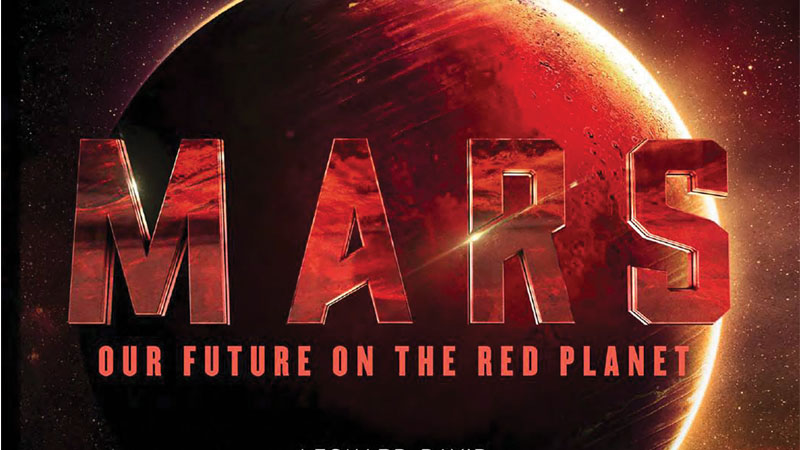Stay Up to Date
Submit your email address to receive the latest industry and Aerospace America news.
Leonard David’s “Mars: Our Future on the Red Planet”
Scientists are just starting to grasp the technical requirements of getting humans to Mars. But what happens to a person’s psyche after being flung into such faraway isolation?
Space journalist Leonard David digs into this and other territory in “Mars: Our Future on the Red Planet,” due out in October from National Geographic. David gives readers a big dose of science and technology, taking readers on a journey to laboratories and test chambers around the world where scientists are working on the challenges of reaching Mars and living there. He unabashedly predicts that people will one day inhabit and even thrive on the extraterrestrial globe.
The book serves as a companion to the National Geographic Channel’s miniseries by Ron Howard and Brian Grazer set to premiere in November. Called “Mars,” the show tracks in docudrama fashion a notional human mission to Mars in the year 2033. An international crew faces trouble from the time of touchdown dozens of kilometers away from the intended target. Problems mount as the months pass, with the governments and private investors back on Earth ready to end a mission they feel they can no longer justify. Then an unexpected discovery gives hope that humanity may endure on Mars after all.
The project builds on momentum created by “The Martian,” the best-selling book and blockbuster movie about an astronaut stranded on the red planet. The miniseries includes interviews with current-day pioneers who are researching and developing technology to get us there.
The book, in six parts and with a foreword by director Ron Howard, explains in often poetic prose what seems like every conceivable challenge of putting “boots on Mars.” They include forging international partnerships to finding a suitable landing site to generate breathable oxygen from Martian carbon dioxide to protecting colonists against radiation, falling boulders and toxic microbes.
“In the 2030s a peculiar shadow slips across the reddish vista that is Mars,” David begins. “In the 21st century, the sandy face of that faraway world is to be dotted by the first footprints of humans.”
In a series of profiles called “Heroes,” David introduces us to the experts working on solutions to those problems. They are among dozens of scientists and academics David interviewed, including twin astronauts Mark and Scott Kelly and NASA planetary protection officer Catharine Conley, whose job is to ensure responsible space exploration.
“I think we hit a chord of things I haven’t seen in one place,” David tells me in a phone interview from his home in Golden, Colorado.
In National Geographic fashion, the book features stunning photos taken by the Opportunity and Curiosity rovers and the Mars Global Surveyor probe, showing the crumbling copper walls of Victoria Crater, the meringue-like peaks of Bagnold Dunes and the smoke-like trails of dust devils.
A chapter called “Mind on Mars” explores the physiological dimensions of exploring those distant, beautiful places.
“The voyage of a crew to Mars is a protracted, perilous one. It is an interplanetary adaptation of the loneliness of a long-distance runner,” David writes. “Confronting and enduring the emotional and mental stresses and strains of just getting to the Red Planet is rough enough, putting aside the psychological tensions of chalking up any lasting stay on Mars.”
Which begs a series of questions: Who should go? What qualities does the ideal interplanetary traveler possess? How do people cope with close-quarter living, cut off from the world they know? The International Space Station provides some indication. So does a series of simulated Mars missions in Earth’s most faraway places, including Devon Island in the Canadian Arctic, an isolation chamber in Russia, and research stations in Antarctica.
So far, David writes, these projects have shown a need to select a Mars crew as a team, rather than individuals. He talked to aerospace engineer and author Robert Zubrin, who argues that the human psyche, while perhaps least understood, will prove to be among the greatest assets.
Finally, David takes us to Marsland — the red planet decades into the future, after humans have established communities there. He challenges us to imagine the unique culture of life on another planet and the children who will be born there. He writes of the shifting values and social changes inevitable in the settlement of new frontiers. He asks us to look beyond the primitive, connected structures in which the first inhabitants will live and work, to a planet that has been terraformed by humans.
NASA space scientist Christopher McKay is already on that task, David writes. The planet could be turned into a place more hospitable to humans by building up the atmosphere with super greenhouse gases. The process, which David acknowledges raises a series of ethical questions, would take generations. Even then, humans would need oxygen outdoors. Such a transformation is also predicated on a successful first mission.
“Mars: Our Future on the Red Planet,” makes a case that success is imminent and that humans will establish a community on Mars relatively soon. As David reminds us: “Danger is always present on the boundaries of exploration, but that hasn’t stopped us before and it won’t stop us this time.” ★
About kristindavis
Sample biography information. Morbi arcu turpis, dignissim ut sodales at, rhoncus eu tortor. Nullam ac enim vehicula, hendrerit metus vel, aliquet quam. In id tempor risus. Curabitur ut consectetur est, a blandit augue. Cras at nunc dolor.
Related Posts
Stay Up to Date
Submit your email address to receive the latest industry and Aerospace America news.






